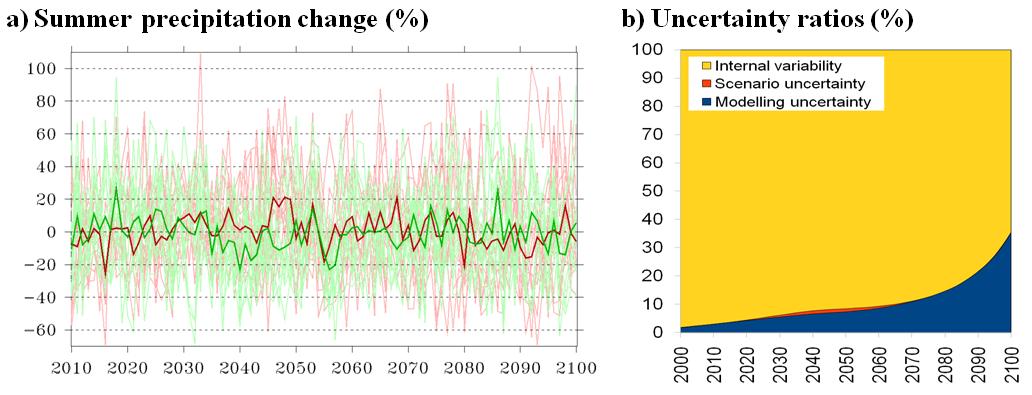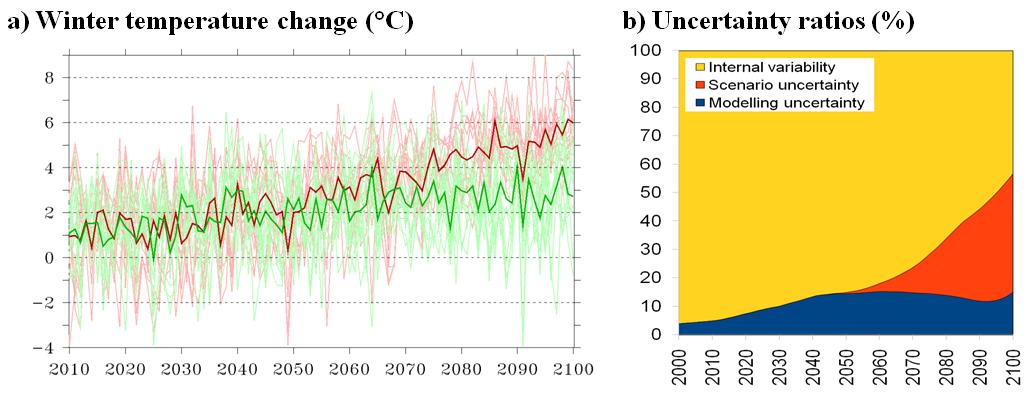Climate model results consist uncertainties, which stem from the followings:
- Natural variability is the inherent part of the climate system causing its continuous change without any external forcing. For instance, two consecutive years can be extremely dry and wet over a region due to this quality.
- Different climate models use various numerical approximations and parameterization schemes to describe physical processes resulting in dissimilar results, as well. The largest diversity occurs in the description of cloud and precipitation processes.
- Climate change is highly influenced by the anthropogenic activity. Its global future path is not known yet and therefore different (optimistic, pessimistic) scenarios are constructed to its estimation. These hypothetical scenarios are taken into account within models through various greenhouse gas concentration pathways.
According to these, one cannot make any reasonable statements based on results of a single climate model run but only through quantifying the projection uncertainties. This could be achieved by applying the ensemble method, when more models and scenarios are considered together and future changes are expressed as probabilistic information.
At the Hungarian Meteorological Service we make detailed assessment on the uncertainties of temperature and precipitation projections (Szabó and Szépszó, 2016), based on the modified method of Hawkins and Sutton (2009, 2011). We study how the total uncertainty could be reduced via model improvements and scenario developments. These investigations may enable us to increase the reliability of the climate change information with finding a representative model ensemble.
Firstly, we evaluated global climate model (GCM) results:
- Global simulations used for the 4th IPCC assessment report (IPCC AR4 WG1, 2007) applying the SRES anthropogenic scenarios (Nakicenovic et al., 2000), collected into the CMIP3 database (Meehl et al., 2007);
- Then simulations of the CMIP5 database (Taylor et al., 2012), where state-of-the-art GCMs with the RCP scenarios (Moss et al., 2010) were used and served as basis for the 5th IPCC assessment report (IPCC AR5 WG1, 2013).
Our investigation continued with the regional climate model (RCM) results. Many CMIP5 model outputs were downscaled onto 50 and 12 km horizontal resolutions using various RCMs within the EURO-CORDEX initiative (Jacob et al., 2014). The detailed assessment of these data supplements the locally-applied RCM results. In addition, it shows whether the application of regional climate models enhance the projection uncertainty. In the DECM project we made systematic catalogues of the entire CMIP5 and EURO-CORDEX data.
Future temperature results based on the EURO-CORDEX RCMs show that with the employment of various scenarios one could get fairly different outcomes over the Carpathian Basin in the last 30-40 years of the 21st century. This effect implies 2-3 °C difference in the winter temperature results by 2100 (Fig. 1). On the contrary, scenario choice is less important or even negligible taking precipitation: projected summer precipitation change is moderately similar for the different scenarios (Fig. 2). In this case, uncertainty emerges from the different approximation of the physical processes in the models, on the one hand. On the other hand, natural variability is a notable uncertainty factor in precipitation projections as it is the case according to the observations. This important “noise” is biasing the precipitation trends resulting in less significant climate change signals around Hungary, even by the end of the 21st century when changes are usually larger.
Figure 1
a) Winter temperature change over the Carpathian Basin compared to 1971–2000 using results of
several regional climate models applying different scenarios (green: RCP4.5, red: RCP8.5);
scenario averages are marked with thick lines
b) Components of total uncertainty over the 21st century regarding the investigated model simulations
Figure 2
a) Summer precipitation change over the Carpathian Basin compared to 1971–2000 using results of
several regional climate models applying different scenarios (green: RCP4.5, red: RCP8.5);
scenario averages are marked with thick lines
b) Components of total uncertainty over the 21st century regarding the investigated model simulations
References
Hawkins, E., Sutton, R., 2009: The potential to narrow uncertainty in regional climate predictions. Bull. Amer. Meteor. Soc. 90, 1095–1107, doi: 10.1175/2009BAMS2607.1.
Hawkins, E., Sutton, R., 2011: The potential to narrow uncertainty in projections of regional precipitation change. Clim. Dyn. 37, 407–418, doi: 10.1007/s00382-010-0810-6.
IPCC AR4 WG1, 2007: Climate Change 2007: The Physical Science Basis, Contribution of Working Group I to the Fourth Assessment Report of the Intergovernmental Panel on Climate Change (eds.: Solomon, S., Qin, D., Manning, M., Chen, Z., Marquis, M., Averyt, K.B., Tignor, M., Miller, H.L.). Cambridge University Press, Cambridge, United Kingdom and New York, NY, USA, 996 p. [PDF – 112 MB]
IPCC AR5 WG1, 2013: Climate Change 2013: The Physical Science Basis. Contribution of Working Group I to the Fifth Assessment Report of the Intergovernmental Panel on Climate Change (eds.: Stocker, T.F., Qin, D., Plattner, G.-K., Tignor, M., Allen, S.K., Boschung, J., Nauels, A., Xia, Y., Bex, V., Midgley, P.M.). Cambridge University Press, Cambridge, United Kingdom and New York, NY, USA, 1535 p. [PDF – 375 MB]
Jacob, D., Petersen, J., Eggert, B., Alias, A., Christensen, O.B., Bouwer, L.M., Braun, A., Colette, A., Déqué, M., Georgievski, G., Georgopoulou, E., Gobiet, A., Menut, L., Nikulin, G., Haensler, A., Hempelmann, N., Jones, C., Keuler, K., Kovats, S., Kröner, N., Kotlarski, S., Kriegsmann, A., Martin, E., van Meijgaard, E., Moseley, C., Pfeifer, S., Preuschmann, S., Radermacher, C., Radtke, K., Rechid, D., Rounsevell, M., Samuelsson, P., Somot, S., Soussana, J.-F., Teichmann, C., Valentini, R., Vautard, R., Weber, B., Yiou, P., 2014: EURO-CORDEX: new high-resolution climate change projections for European impact research. Regional Environmental Change 14, 563–578, doi: 10.1007/s10113-013-0499-2,
Meehl, G.A., Covey, C., Delworth, T., Latif, M., McAvaney, B., Mitchell, J.F.B., Stouffer, R.J., Taylor, K.E., 2007: The WCRP CMIP3 multi-model dataset: A new era in climate change research. Bull. Amer. Meteor. Soc. 88, 1383–1394, doi: 10.1175/BAMS-88-9-1383.
Moss, R.H., Edmonds, J.A., Hibbard, K.A., Manning, M.R., Rose, S.K., van Vuuren D.P., Carter T.R., Emori, S., Kainuma, M., Kram, T., Meehl, G.A., Mitchell, J.F.B., Nakicenovic, N., Riahi, K., Smith, S.J., Stouffer, R.J., Thomson, A.M., Weyant, J.P., Wilbanks, T.J., 2010: The next generation of scenarios for climate change research and assessment. Nature 463, 747–756, doi: 10.1038/nature08823.
Nakicenovic, N., Alcamo, J., Davis, G., de Vries, B., Fenhann, J., Gaffin, S., Gregory, K., Grübler, A., Jung, T.Y., Kram, T., La Rovere, E.L., Michaelis, L., Mori, S., Morita, T., Pepper, W., Pitcher, H., Price, L., Raihi, K., Roehrl, A., Rogner, H.H., Sankovski, A., Schlesinger, M., Shukla, P., Smith, S., Swart, R., van Rooijen, S., Victor, N., Dadi, Z., 2000: IPCC special report on emissions scenarios. Cambridge University Press, Cambridge, United Kingdom, 570 p. [PDF]
Szabó, P., Szépszó, G., 2016: Quantifying Sources of Uncertainty in Temperature and Precipitation Projections over Different Parts of Europe. In: Mathematical Problems in Meteorological Modelling. Mathematics in Industry (eds.: Bátkai, A., Csomós, P., Faragó, I., Horányi, A., Szépszó, G.), Springer International Publishing, 207–237, doi: 10.1007/978-3-319-40157-7_12.
Taylor, K.E., Stouffer, R.J., Meehl, G.A., 2012: An Overview of CMIP5 and the experiment design. Bull. Amer. Meteor. Soc. 93, 485–498, doi: 10.1175/BAMS-D-11-00094.1.












